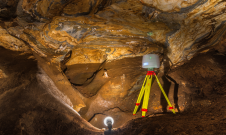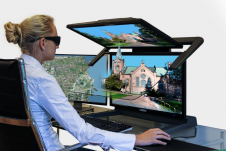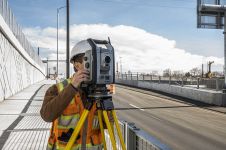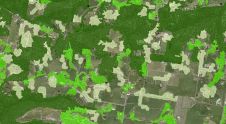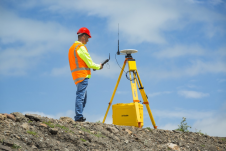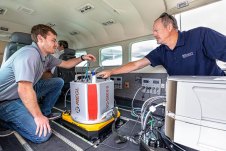UAVs vs MAVs
James Eddy, technical director of Bluesky International and Industrial Associate at the University of Leicester explores the growing phenomena of Unmanned Aerial Vehicles in the UK and discusses the potential impact on the aerial mapping, surveying and GIS sectors.
For many years unmanned aircraft were flown by model aircraft enthusiasts. Basic models cost less than a hundred pounds with more upmarket systems for a thousand or more. Now unmanned aircraft (UAs), unmanned aerial vehicles (UAVs), unmanned aerial systems (UASs), remotely piloted aircraft (RPAs), drones – whatever term is in favour this week, are increasingly used for professional applications for data gathering. With around 500 registered commercial UAV operators in the UK alone these aircrafts are being promoted as an alternative to traditional Manned Aerial Vehicles (MAV – i.e. dedicated aerial survey planes, with pilot and sensor operators) with claims of cost savings and operational efficiencies. Are UAV’s the next revolution to hit the remote sensing industry?
Arguing the Case For and Against
As an aerial survey company we are often asked which UAV we use for capturing and maintaining our nationwide, high resolution aerial photography dataset. The simple answer is we don’t! We have invested a significant amount of money and time researching the latest developments in aerial survey equipment and practices, in purchasing state-of-the-art sensors and navigation systems, and maintaining and operating aircraft, pilots and crew.
And there is a reason for this. We maintain a national dataset updated every three years, which means capturing between 40-50,000 square kilometres of data annually. We use an UltraCam Eagle 262 Mpx camera with an image footprint of at least 20,000 pixels, an image capture rate of 3.7 gigabits per second and an integrated storage capacity of four thousand images. It captures up to 1,000 square kilometres of 8 cm resolution imagery per day. UAVs currently offered for aerial survey work capture a maximum of 5 to 10 square kilometres at the same resolution. That’s less than 10% of the aeroplane’s output.
For aerial survey work, as distinct from just taking pictures, we need to consider the accuracy of the data and that is compromised by the very small, lightweight sensors on UAVs – especially if flown in less than perfect conditions. One system is marketed at the ‘advanced’ user requiring high grade data and accuracy. The sixteen page brochure highlighted potential cost savings through speed of data capture across a range of applications including agricultural land survey, archaeological site investigation and stock pile volume estimations. The brochure describes the benefits of a modular design; a range of safety features; and an automated workflow enabling a non-specialist to process thousands of aerial images on a desktop computer to produce high grade photogrammetric data. There was not a single mention of GPS or inertial positions.
Such a system may not produce very high quality output – but what are the benefits? The ready-to-fly system cost is from around £13,000 complete with training. This means that, with few operational overheads, UAV operators can significantly undercut traditional MAV providers which have equipment costs in hundreds of thousands of pounds with additional, and significant, operating and maintenance costs.
The speed of deployment is also much faster. A typical UAV can be carried in a car and can easily be transported and launched from just about anywhere. The UAV perfectly suited for time sensitive missions as well those applications where speed is of the essence - such as emergency service applications. UAV operators are also less restricted by the good old British weather! So UAV operators can be very quick to react – responding to a given event or request in literally a few hours depending on the proximity of the mission.
Regulation Plays a Role
According to the Civil Aviation Authority’s (CAA) website; ‘unlike manned aircraft or model aircraft used for recreational purposes, there are no established guidelines for professional UAV operations and therefore operators may not be aware of the potential dangers or indeed the responsibility they have towards not endangering the public’.
In 2010 the CAA introduced new regulations requiring operators of small unmanned aircraft used for ‘aerial work’ purposes and craft equipped for data acquisition and/or surveillance to obtain permission from the CAA before ‘commencing a flight in a congested area or in proximity to people or property’. These include an overriding / all encompassing article which states ‘A person must not recklessly or negligently cause or permit an aircraft to endanger any person or property’.
Article 166 addresses the issue of visual contact with the UAV, the dropping of articles and the operation of the craft in specific airspace. An additional clause covers the operation of UAV’s for the purpose of aerial work and that they may only be flown in accordance with permission granted. CAA does address the use of ‘small unmanned surveillance aircraft’ when equipped to undertake any form of surveillance or data acquisition. Additional operating regulations include minimum distance from people or properties. The CAA guidelines also draw operators’ attention to the Data Protection Act.
In the USA, the Department of Transportation (DOT) and Federal Aviation Administration (FAA) are currently proposing new rules for small unmanned aircraft systems. The proposal offers a range of safety rules for operators conducting non-recreational operations including limiting of flights to daylight and visual line of sight operations. The FAA proposals would also address height restrictions, operator certification, optional use of a visual observer, aircraft registration and marking and operational limits.
如果通过这些建议能大大curtail the research by Amazon, Google and DHL into ‘parcelcopters’ or ‘delivery drones’ and for aerial survey operations this would reduce the potential for large scale operations and certainly prevent their use for night time thermal surveys.
A Flash in the Pan or Here to Stay?
Last year the UK’s first show dedicated to the commercial UAV market attracted more than 1,500 visitors, 59 exhibitors with a programme of case studies, commercial presentations and industry seminars. In 2015 these figures are expected to double. A quick look at the show’s agenda reveals a mix of subjects including platform, power and payloads, data capture and analysis, regulation, working with other technologies and emerging applications. The speakers are really diverse including the UAV suppliers, fire and rescue services, police forces, academic institutions as well as the BBC, Met Office, Thames Water, English Heritage and British Antarctic Survey.
In addition, a range of reports predict significant growth in this sector of the world aerospace industry. A report by the Teal Group, who describe themselves as ‘the source for aerospace and defence industry market analysis’ predicts that UAV spending will nearly double over the next decade. In the eleventh edition of this sector study the report estimates current expenditure of $6.4 billion annually will rise to $11.5 per annum totalling almost $91 billion in the next ten years. All of this would suggest that there are some serious supporters of UAVs with serious budgets!
So in Conclusion. . . in my Humble Opinion
Are UAV’s here to stay. . . YES. There has been so much investment to date and so many successful applications to simply dismiss this emerging technology as a fad.
Do they have a place in the aerial survey and mapping sector. . . DEFINITELY; where small area surveys are required and speed or timing of deployment is of greater consideration than data accuracy then UAV’s will win every time. Throw in the cost consideration for commissioned surveys rather than off-the-shelf data purchase and its win win.
Will they replace MAV’s. . . NO. Not until we have large, solar powered UAV’s flying at 60,000 feet able to continuously download fully orthorectified aerial images over a large area. Then it might be time to retire – or make sure we have already bought in to the technology!
Is there an alternative threat to MAV’s. . . I THINK SO. Perhaps a more realistic competitor is satellite imagery. When temporal frequency, control and spatial resolution match that of traditional aerial surveys then I may have to consider trading in my trusted plane and trading up!
Do I still want a UAV. . . OF COURSE. I have recently seen some stunning 2cm resolution images captured by a UAV and a half decent DSM and for once I might be allowed to take to the skies as the pilot!
This article was published in GIS Professional April 2015
Make your inbox more interesting.Add some geo.
Keep abreast of news, developments and technological advancement in the geomatics industry.
Sign up for free













